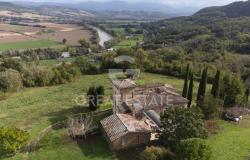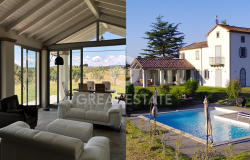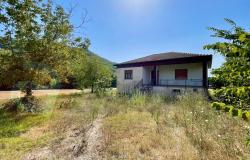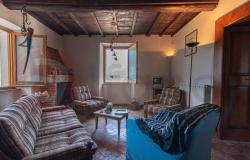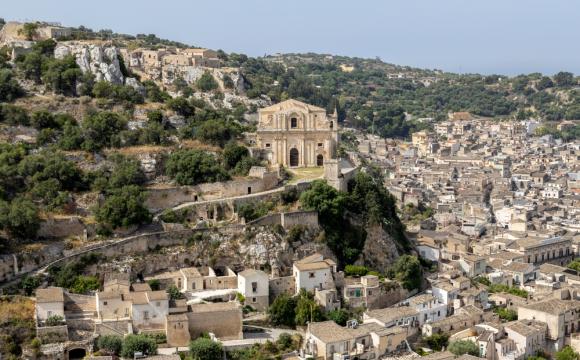 “If it rains on the palms, it won’t rain on the eggs,†says an old proverb describing the weather between Palm Sunday and Easter. Easter season in Northern Lazio, also known as Etruria or the Viterbese, has a full schedule of Holy Week happenings and unusual daytrips to satisfy both nature lovers and those interested in Italy’s traditions.
“If it rains on the palms, it won’t rain on the eggs,†says an old proverb describing the weather between Palm Sunday and Easter. Easter season in Northern Lazio, also known as Etruria or the Viterbese, has a full schedule of Holy Week happenings and unusual daytrips to satisfy both nature lovers and those interested in Italy’s traditions.
On Good Friday evening, processions of great intensity take place in many towns. At Vetralla, statues of the dead Christ and a Madonna covered with heart-shaped silver ex-votos and pierced with seven silver swords are carried in a candlelit procession through the historic center.
Particularly touching processions are held in Bagnaia, in Bagnoregio, and in Tuscania where mourners in black follow barefoot penitents who drag heavy chains. Orte’s torchlight procession has a gilded baroque sarcophagus of the dead Christ carried by members of confraternities in different colored robes and hoods.
In the old Etruscan town of Blera the procession includes statues of Christ, the Madonna, hooded and chain-dragging penitents and black-robed sodality members chanting popular laments dating back hundreds of years. Chinese lanterns and candles light the streets and the solemnity and silence are moving, then the town band strikes up, enlivened by the addition of Biblical “interpreters†including Roman soldiers on horseback. The climax of the procession is the Crucifixion scene with local actors portraying Christ and the two thieves .
Saturday is set aside for preparing the Easter feast based on roast lamb and some families still make the traditional cakes known as pizze di Pasqua at home.
Easter Sunday begins with families sharing a brunch of pizza, sliced meats and hard-boiled eggs, symbolizing the resurrection. In some towns, it is the one time during the year when the churches are filled to capacity.
At 5 p.m., Tarquinia, 62 miles north of Rome, is the stage for the Corsa Della Resurrezione, or Resurrection Race, when the 19th century statue of Christ in Glory is carried through the streets to the music of the town band and pealing church bells. The statue is greatly loved by the Tarquinese and when asked if they would donate it to the Vatican, they answered, “not even in exchange for the Pietà di Michelangeloâ€.
The noise is multiplied by local hunters who join the parade shooting off their guns loaded with colorful confetti. Nine tall crosses decked with leafy garlands and strangely resembling maypoles or Celtic crosses are carried by trios of young men for the uphill run. If the sun shines and if the statue dances, Cristo che balla, it will be a good year, tradition says.
Easter Monday is known as Pasquetta and is celebrated with the first outing of the year when Tuscia’s green fields, woods and nature reserves are invaded by picnickers. One favourite picnic place is the nature park surrounding the medieval walled town of Barbarano Romano. Here a well-equipped visitor’s centre (Centro visite del parco) provides itineraries of medium difficulty: the Etruscan tombs of San Giuliano, the ancient Via Clodia and an excursion along the wild canyons to the town of Blera.
Another of the area’s strange rites of spring is the Wedding of the Trees Sposalizio dell’Albero that is performed each May 8th by the mayor of Vetralla wearing his tri-color sash. Just as Venice is “wedded to the sea,†so Vetralla with this simple ceremony, reinstates its sovereignty over the forests, continuing the right of each citizen to a cubic meter of firewood annually. The couple of giant oaks are draped with veils and garlands, horsemen offer bouquets of the first spring flowers and new trees are planted while a picnic lunch is offered to all at the town’s expense. Details: May 8, 11 a.m. - 1 p.m.
 The festival known as La Barabbata in Marta is the prototype of all May fairs and perhaps the most important day in the year for this town on the shores of Lake Bolsena. Dressed as representatives of the old trades, the men (the women are only onlookers) carry their tools in a procession through the town with white buffalo helping to pull the 20-odd homemade floats piled high with the fruits of their work: wheat sheaves, cheeses, flowers, fruits, the gigantic lake fish and eels . Details: May 14, 10 a.m. - 2 p.m.
The festival known as La Barabbata in Marta is the prototype of all May fairs and perhaps the most important day in the year for this town on the shores of Lake Bolsena. Dressed as representatives of the old trades, the men (the women are only onlookers) carry their tools in a procession through the town with white buffalo helping to pull the 20-odd homemade floats piled high with the fruits of their work: wheat sheaves, cheeses, flowers, fruits, the gigantic lake fish and eels . Details: May 14, 10 a.m. - 2 p.m.
American-Irish writer and historian Mary Jane Cryan has been living in Italy since 1965. She has taught at international schools in Rome, Genoa and Moscow, American and Italian universities and Elderhostel . She is presently teaching “Italian Culture†to American students attending the Università della Tuscia in Viterbo.
Book reviews and up-to-date information are available on www.elegantetruria.com
Contact: macryan@alice.it


